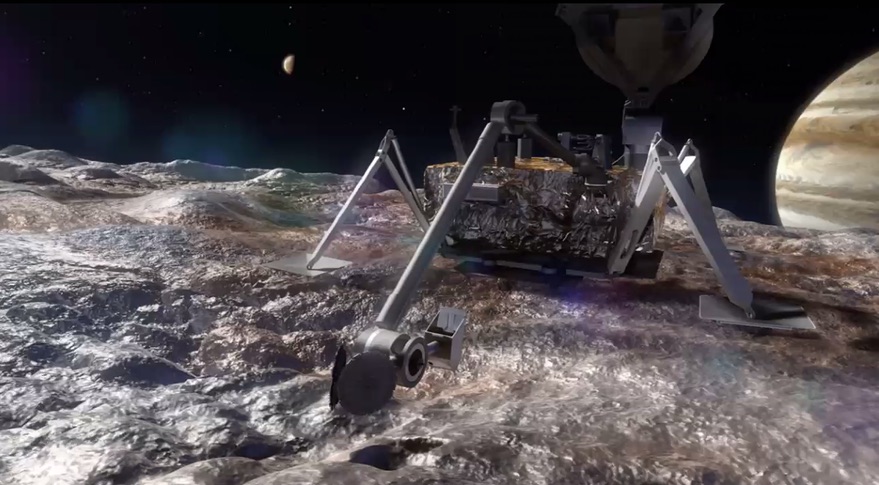NASA Wants Science Instrument Ideas for Europa Lander Mission

NASA's potential lander mission to Jupiter's ocean-harboring moon Europa may start taking shape soon.
The agency has asked scientists to submit their ideas for instruments for the multibillion-dollar lander, which would look for signs of past or present life on Europa at or near the moon's icy surface, among other work.
"It's official! We're accepting instrument proposals to include on a robotic lander that could go to the surface of Jupiter’s moon Europa. What concept would best help NASA and a potential future robot explore this icy world? Submit your ideas by Aug. 24: https://go.nasa.gov/2Iu0mdf," Thomas Zurbuchen, the head of NASA's Science Mission Directorate, said via Twitter yesterday (May 17). [Photos: Europa, Mysterious Icy Moon of Jupiter]
Europa, which is a little smaller than Earth's moon, has a huge ocean of liquid water beneath its icy shell. NASA is currently developing a Jupiter-orbiting mission called Europa Clipper, which is scheduled to launch in 2022. The mission will investigate the Europa ocean's life-hosting potential, gathering data during 40 to 45 flybys that get as close as 16 miles (25 kilometers) to the moon's surface.
And Europa Clipper may even be able to grab samples during some of these flybys. A plume of water vapor appears to emanate from Europa, at least intermittently. It's unclear at the moment if this material is coming all the way from the ocean, or from a reservoir closer to the surface.
Compared to the Clipper mission, the battery-powered Europa lander is on less solid ground; it's a concept at this point, not an officially approved mission. But, as the new call for proposals shows, NASA is working to flesh out the project's scientific activities.
According to the solicitation, the lander's entire scientific payload would have a maximum mass of 73 lbs. (33 kilograms) and would be expected to operate for 20 days on the surface of Europa. (That surface is a very harsh environment: In addition to be being very cold, it's within Jupiter's radiation belt and therefore gets hammered by fast-moving particles. Conditions are more benign in the subsurface, which is shielded by ice.)
Get the Space.com Newsletter
Breaking space news, the latest updates on rocket launches, skywatching events and more!
The solicitation also stresses that any Europa lander instruments must be at Technology Readiness Level (TRL) 6 by the end of 2022. NASA's TRL scale goes from 1 to 9; a TRL of 6 means that an instrument has "a fully functional prototype or representational model." (At TRL 7, that instrument has been demonstrated in the space environment.)
Current thinking about the potential lander envisions a launch no earlier than 2025, aboard NASA's in-development Space Launch System rocket, and a landing on Europa six years later. Mission team members have said they aim to keep the possible lander mission's cost under $3 billion.
In late 2015, Congress directed NASA to investigate the possibility of adding a lander component to Europa Clipper. The agency subsequently determined that launching the lander separately, after Clipper, would be the best way to go.
Follow Mike Wall on Twitter @michaeldwall and Google+. Follow us @Spacedotcom, Facebook or Google+. Originally published on Space.com.
Join our Space Forums to keep talking space on the latest missions, night sky and more! And if you have a news tip, correction or comment, let us know at: community@space.com.

Michael Wall is a Senior Space Writer with Space.com and joined the team in 2010. He primarily covers exoplanets, spaceflight and military space, but has been known to dabble in the space art beat. His book about the search for alien life, "Out There," was published on Nov. 13, 2018. Before becoming a science writer, Michael worked as a herpetologist and wildlife biologist. He has a Ph.D. in evolutionary biology from the University of Sydney, Australia, a bachelor's degree from the University of Arizona, and a graduate certificate in science writing from the University of California, Santa Cruz. To find out what his latest project is, you can follow Michael on Twitter.









